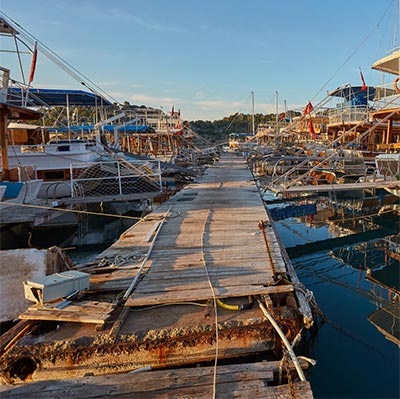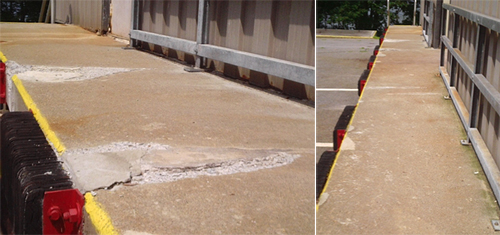Efficient Dock Repair Techniques: Guaranteeing Structural Stability
Making sure the structural honesty of anchors with reliable repair service techniques is extremely important for the longevity and safety and security of aquatic centers. This involves a multi-faceted approach beginning with comprehensive examinations using advanced modern technologies like finder equipment and from another location ran vehicles (ROVs) to detect both noticeable and hid problems. Subsequently, choosing the ideal repair materials, such as corrosion-resistant alloys and composite materials, is essential for longevity. Structural support approaches, including the application of cross-bracing systems and load-distribution plates, play a crucial duty in mitigating stress factors. However, the value of these techniques ends up being noticeable when discovering sophisticated repair work approaches and preventative upkeep methods.
Evaluating Dock Damages
Evaluating dock damage is a critical very first action in guaranteeing the structural honesty and safety of any type of docking facility. Key facets to analyze include the dock's structure, pilings, decking, and equipment (Dock Repairs).
Architectural designers or qualified inspectors usually carry out these analyses making use of specialized devices and techniques. Undersea examinations could use sonar devices or from another location operated automobiles (ROVs) to identify immersed damages. Above water, visual assessments are complemented by utilizing wetness meters and various other analysis devices to reveal underlying problems not instantly visible to the naked eye.

Choosing Repair Work Materials
Choosing the ideal fixing materials is a pivotal step in the dock repair procedure, one that straight affects the long life and performance of the repaired structure. Material selection should be driven by aspects such as ecological problems, load-bearing needs, and compatibility with existing dock components. Timber is a standard selection for anchors due to its natural durability and aesthetic appeal. Choosing the appropriate kind of timber, such as pressure-treated lumber or naturally rot-resistant species like cedar or teak, is crucial to withstand aquatic settings.
In addition to wood, composite products are progressively popular due to their resilience and low upkeep demands. Composites, typically made from a mix of plastic and wood fibers, supply superb resistance to rot, pests, and UV damages. For steel docks, choosing corrosion-resistant alloys such as galvanized steel or marine-grade aluminum is vital to avoid rust and ensure architectural honesty in saline water conditions.
Epoxy resins and marine-grade sealers are vital for repairing cracks and sealing joints, offering a waterproof obstacle and enhancing the dock's total strength. By diligently picking high-grade materials, dock repair work can achieve resilient results, consequently protecting versus future deterioration and making certain secure, trusted usage.
Structural Support Strategies
Reliable structural support strategies are crucial in guaranteeing the stability and durability of dock repair services. This approach is specifically reliable for anchors revealed to heavy loads redirected here or harsh environmental conditions.
One more necessary strategy is the application of fiber-reinforced polymers (FRP) These materials provide high strength-to-weight ratios and outstanding resistance to rust, making them suitable for enhancing concrete or wood anchors. FRP can be used in sheets or strips and bonded with epoxy resins to improve architectural integrity.
Supporting and securing systems likewise play a critical duty in structural reinforcement. Cross-bracing, making use of steel or wooden beams, can counteract side pressures, lowering persuading and motion. Anchoring systems, such as helical piers or driven piles, give a steady foundation by transferring lots to much deeper, a lot more steady dirt layers.
Finally, the integration of load-distribution plates can help distribute weight more evenly throughout the dock's surface, alleviating localized tension points. These methods collectively guarantee that docks remain safe and durable, with the ability of holding up against the rigors of their functional atmosphere.
Advanced Repair Work Methods

An additional advanced method entails undersea welding, which permits fixings to be performed without the need to dewater the area. This method is particularly beneficial for attending to architectural concerns in immersed dock elements, making certain marginal disturbance to operations. Enhanced welding techniques, coupled with robot systems, supply accuracy and integrity, therefore expanding the lifespan of the dock.
Additionally, cathodic security systems are carried out to stop corrosion in metallic dock frameworks. By using sacrificial anodes or amazed present systems, these techniques successfully alleviate the electrochemical procedures that bring about product deterioration.
Lastly, progressed surveillance technologies, such as structural health monitoring (SHM) systems, offer real-time data on the condition of dock structures. These systems allow proactive maintenance and timely treatments, inevitably look at here making certain the lasting architectural honesty of the dock.
Upkeep and Avoidance
Maintenance and avoidance are essential ideas that underpin site here the durability and safety of dock structures. Normal evaluations are paramount, enabling early discovery of deterioration, potential weaknesses, and ecological impacts. An aggressive method, entailing routine look for corrosion, rot, and architectural shifts, minimizes costly repair services and prolongs the dock's functional life.
Safety nets should include using protective layers to metal parts to defend against rust and utilizing cured wood to withstand degeneration. Additionally, making sure correct drainage and air flow can stop water buildup, which is a common root cause of structural deterioration. Including quality materials and sticking to supplier guidelines during building and fixing phases likewise play vital duties in enhancing toughness.

Educating workers in dock maintenance best techniques makes certain constant application of safety nets. Leveraging technological breakthroughs, such as drones for examinations and sensing units for real-time tracking, can further enhance upkeep efforts. By prioritizing upkeep and avoidance, dock owners can make certain architectural stability, operational safety and security, and economical management over the dock's life-span.
Final Thought
In conclusion, keeping the structural stability of aquatic centers necessitates detailed dock repair techniques. Advanced fixing techniques, combined with normal upkeep methods, make certain the dock remains risk-free and functional under diverse environmental conditions.
Making sure the architectural honesty of docks via reliable repair methods is extremely important for the longevity and security of marine centers.Selecting the suitable fixing products is a pivotal step in the dock remediation process, one that directly influences the durability and efficiency of the fixed framework.Effective structural reinforcement methods are essential in guaranteeing the security and long life of dock fixings. By prioritizing maintenance and avoidance, dock proprietors can ensure structural integrity, operational security, and economical administration over the dock's life-span.
In verdict, preserving the structural stability of marine facilities necessitates extensive dock repair work methods.